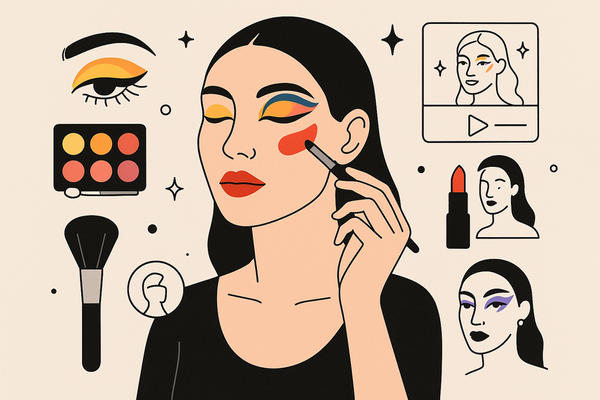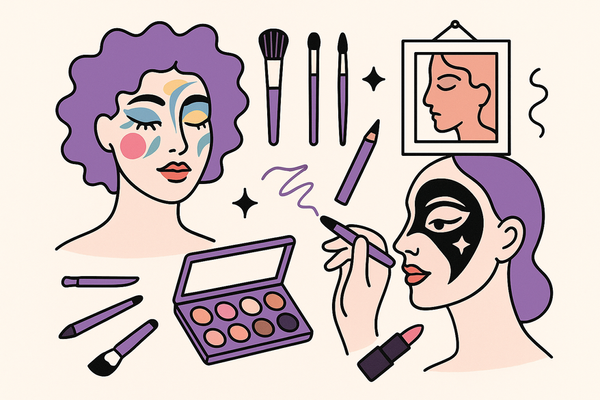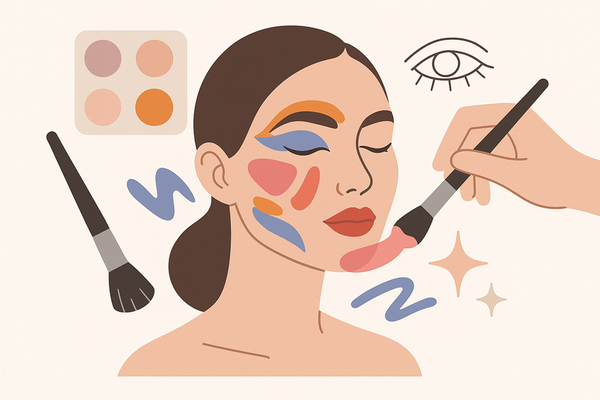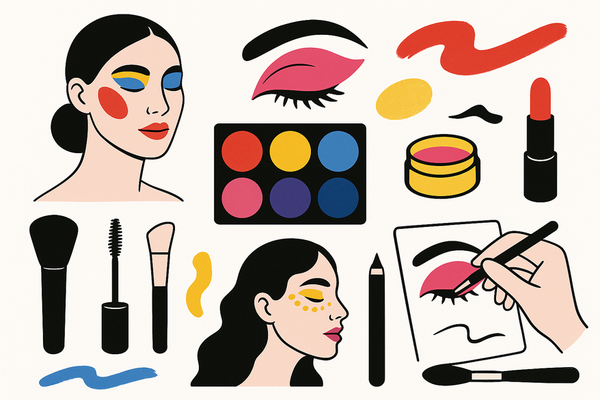Creative Makeup Designs: A Comprehensive Guide to Self-Expression
Explore creative makeup designs, their history, essential techniques, and tools to craft artistic expressions. Unleash your creativity through cosmetics.
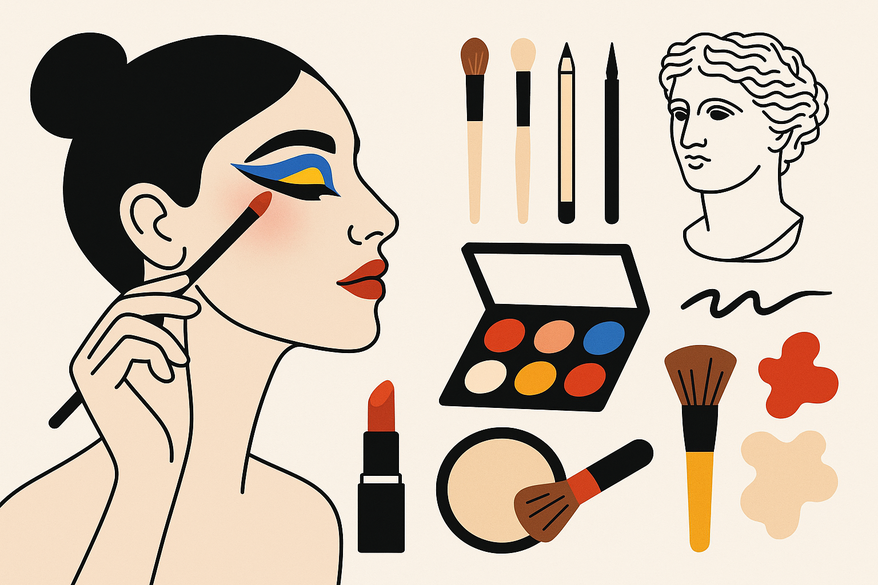
Estimated reading time: 12 minutes
Key Takeaways
- Evolution: Trace makeup’s artistic journey from ancient rituals to modern avant-garde.
- Techniques: Understand foundational color theory, precision brushwork, and embellishment methods.
- Tools & Materials: Discover essential brushes, high-pigment products, adhesives, and specialty applicators.
- Process: Follow a clear, step-by-step workflow from concept development to finishing touches.
- Inspiration: Explore real-world examples and community trends for continual creativity.
Table of Contents
- Introduction
- Background and Evolution
- Key Elements
- Tools and Materials
- Step-by-Step Process
- Inspiration and Examples
- Tips and Best Practices
- Conclusion
Introduction
Creative makeup designs are artistic expressions using cosmetics that transcend basic beauty enhancement, incorporating elements of fine art, theatricality, and avant-garde aesthetics. These innovative looks push creative boundaries, redefine beauty standards, and serve as powerful tools for self-expression, performance, and visual storytelling. In this guide, you’ll discover:
- The historical evolution of creative makeup designs
- Core techniques and color theory fundamentals
- Must-have tools, high-pigment products, and specialty materials
- A detailed, step-by-step application process
- Inspirational examples and community trends
- Expert tips, hygiene practices, and ways to overcome common challenges
For those looking to experiment with virtual look generation and immediate style feedback, Makeup Check AI provides an intuitive platform to brainstorm creative makeup designs before picking up a brush.
By the end, you’ll be equipped to craft your own imaginative face and body art.
Background and Evolution of Creative Makeup Designs
Historical Roots of Creative Makeup Designs
From the Nile shores to modern studios, ancient Egyptians applied malachite, ochre, and kohl not only to beautify but to convey ritual status and mythic narratives. Pharaohs and priests used color as a storytelling tool—green for fertility, black for rebirth.
- Pigments on papyrus and tomb art mirrored ceremonial face painting.
- Eye decorations signified protection against evil and solar worship.
- Tools included reed sticks, stone palettes, and animal-fat binders.
Cultural Shifts in Creative Makeup Designs
As societies evolved, expressive cosmetics took on new roles:
- Medieval courts and Renaissance theaters used pigments to denote rank and amplify stage features.
- 20th-century cabaret and drag culture embraced bold color blocks, feathers, and rhinestones.
- Avant-garde artists added collage textures and abstract shapes for social commentary.
Modern Trends in Creative Makeup Designs
Digital platforms and fashion runways drive today’s experimental looks:
- Instagram artists share avant-garde illustrations with neon pigments and chrome shadows.
- TikTok challenges encourage galaxy motifs, UV-reactive tribal patterns, and microbiome-inspired dots.
- Film and couture shows feature 3D prosthetics, metallic leaf highlights, and interactive LED attachments.
For more AI-fueled creative makeup explorations and artistic makeup inspiration, explore these platforms.
Key Elements of Creative Makeup Designs
Color Theory in Creative Makeup Designs
A strong grasp of color relationships transforms flat painting into dynamic spectacle:
- Hue: Pure pigments like reds, blues, and greens.
- Contrast: Opposites on the color wheel create focal pops.
- Harmony: Analogous combinations yield smooth transitions.
- Saturation & Value: Adjust brightness and intensity to sculpt depth.
Use a color wheel as your roadmap—complementary choices intensify, triads balance, and tetrads craft complex harmony.
Brush & Application Techniques for Creative Makeup Designs
- Blending: Tapered brushes fuse colors seamlessly.
- Contouring & Highlighting: Angled brushes shape planes with control.
- Graphic Line Work: Fine-tip brushes or gel liners enable razor-sharp shapes.
- Stippling & Dabbing: Dotting tools create textures or galaxy starfields.
Precision in Creative Makeup Designs
- Layering order: Start with light guides, then build pigment.
- Deliberate strokes under bright lighting prevent color bleed.
- Touch-up tools like cotton swabs and micellar water correct stray marks.
Texture & Embellishments in Creative Makeup Designs
- Gems & rhinestones affixed with skin-safe adhesives for disco effects.
- Glitters & micro-beads over wet primer for lasting sparkle.
- Foils & leafing catch light for editorial shoots.
- Prosthetics sealed with spirit gum for fantasy characters.
Tools and Materials for Creative Makeup Designs
Professional Brushes for Creative Makeup Designs
- Tapered blending brushes for gradients.
- Angled contour brushes for carving.
- Fine-tip detail brushes for micro-lines and graphic accents.
High-Pigment Products for Creative Makeup Designs
- Cream & powder palettes with full-coverage pigments.
- Gel liners & liquid pigments for graphic work.
- Neon & UV-reactive shadows for performance art.
- Pressed cosmetic glitters for safe sparkle.
Sponges & Specialty Tools for Creative Makeup Designs
- Beauty sponges for smooth canvases.
- Silicone applicators for metallics and foils.
- Dotting tools and micro-brushes for consistent patterns.
Adhesives & Sealers for Creative Makeup Designs
- Medical-grade adhesives for gems and prosthetics.
- Gentle solvent removers to preserve skin health.
- Setting sprays & sealants for heat and humidity resistance.
Product Selection Tips for Creative Makeup Designs
- Choose long-wear, high-pigment formulas rated for editorial use.
- Patch-test new ingredients 24–48 hours before full application.
- Prioritize hypoallergenic and non-comedogenic options.
Step-by-Step Process for Creative Makeup Designs
1. Concept Development for Creative Makeup Designs
- Gather inspiration from art history, nature, fashion editorials, or film stills.
- Create mood boards to map color schemes and textures.
- Sketch rough designs to test symmetry and flow.
2. Preparation for Creative Makeup Designs
- Double-cleanse, tone, and apply silicone-free primer.
- Organize tools and products in workflow order.
- Protect hairlines and clothing with barrier sheets.
3. Base Application for Creative Makeup Designs
- Apply full-coverage foundation or body paint with a damp sponge.
- Neutralize discolorations with correctors.
- Lightly contour to define planes without overpowering pigments.
4. Color & Feature Mapping for Creative Makeup Designs
- Sketch key shapes with white eyeliner or translucent powder.
- Anchor designs at inner eye corners, brow arches, and cupid’s bow.
- Verify balance under consistent lighting before proceeding.
5. Layering & Detailing for Creative Makeup Designs
- Build pigment in thin layers; start with gel liners and finish with powders.
- Blend edges with fluffy brushes and sharpen shapes with fine tips.
- Affix embellishments last using adhesive and tweezers.
6. Finishing Touches for Creative Makeup Designs
- Seal with a micro-fine mist of setting spray.
- Inspect under natural and artificial light for smudges.
- Add micro-highlights or tiny glitters for sparkle.
- Photograph from multiple angles for portfolios.
Inspiration and Examples of Creative Makeup Designs
Example A: Neon Geometric Face Art
Runway artist X uses UV-reactive pigments to paint sharp triangles and stripes across the forehead and cheeks. The contrast of neon green and fuchsia creates an optical illusion under blacklight.
Example B: Galaxy Motif Tutorial on TikTok
Blend deep blues, purples, and magentas into a cosmic gradient on lids and temples. Use star stencils and micro-glitter for stellar accents.
Example C: Editorial Prosthetic Sci-Fi Shoots
Silicone cheek and eyebrow appliqués simulate android panels with embedded micro-LEDs. Edges are sealed seamlessly and highlighted with metallic foils.
Tips and Best Practices for Creative Makeup Designs
Experiment Gradually with Creative Makeup Designs
- Begin with single-color geometric shapes before layering hues.
- Master simple stencil techniques before freehand linework.
Master Fundamentals of Creative Makeup Designs
- Daily drills: blend primary colors and replicate on skin.
- Symmetry checks: practice winged eyeliner exercises.
- Color-matching: test combinations under natural light.
Overcome Challenges in Creative Makeup Designs
- Precision: use magnifying lamps and fine brushes.
- Allergies: patch-test pigments and adhesives ahead of time.
- Time management: set timers for each stage to maintain momentum.
Hygiene & Professionalism in Creative Makeup Designs
- Sanitize brushes and sponges before use.
- Use disposable applicators for sensitive areas.
- Label and date custom mixes for consistency.
- Document builds with notes and photos.
Continuous Learning for Creative Makeup Designs
- Enroll in masterclasses on SFX, body painting, or editorial trends.
- Subscribe to industry journals and tutorial channels.
- Attend conventions like IMATS and BeautyCon for live demos.
Conclusion
Creative makeup designs blend history, science, and artistry to unlock limitless storytelling and self-expression. You now have a roadmap—from evolution and techniques to tools, step-by-step processes, and best practices—to craft your own avant-garde looks. Gather your brushes, sketch your first masterpiece, and share it with the #CreativeMakeupDesigns community. Keep exploring, learning, and pushing the boundaries of cosmetic art.
FAQ
- Q: What essential tools do I need to start?
A: Begin with basic brushes (blending, contour, fine-tip), high-pigment palettes, a reliable adhesive, and a setting spray. - Q: How can I ensure my designs last?
A: Use primer, build pigment in layers, affix embellishments with medical-grade glue, and seal with a fine mist of setting spray. - Q: How do I maintain hygiene when working on others?
A: Sanitize tools before each use, employ disposable applicators for eyes and lips, and patch-test products on clients. - Q: Where can I find inspiration?
A: Follow hashtags like #CreativeMakeupDesigns on social media, join artist forums, and attend industry events for live demos and feedback.

